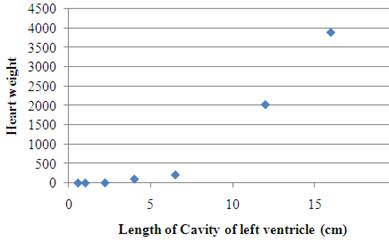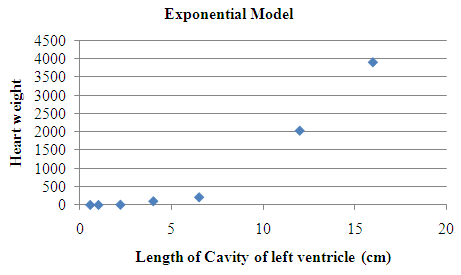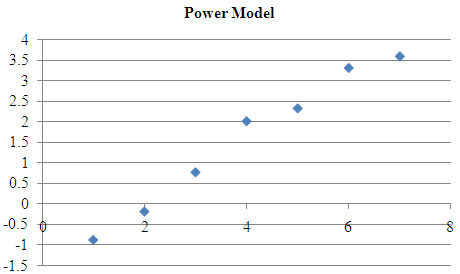
Concept explainers
(a)
To construct: an appropriate
(a)
Answer to Problem 49E
Positive curve strong
Explanation of Solution
Given:
| Mammal | Length of Cavity of left ventricle (cm) | Heart weight |
| Mouse | 0.55 | 0.13 |
| Rat | 1 | 0.64 |
| Rabbit | 2.2 | 5.8 |
| Dog | 4 | 102 |
| Sheep | 6.5 | 210 |
| Ox | 12 | 2030 |
| Horse | 16 | 3900 |
Graph:
Scatter plot

Form: curve, the reason is that the points are not lying on the straight line
Direction: Positive, the reason is that the scatter plot slope is going to upwards.
Strength: strong, the reason is that all points lie very near together in the same pattern.
(b)
To Explain: that this relationship follows an exponential model or a power model.
(b)
Answer to Problem 49E
Power Model
Explanation of Solution
Given:
| Mammal | Length of Cavity of left ventricle (cm) | Heart weight |
| Mouse | 0.55 | 0.13 |
| Rat | 1 | 0.64 |
| Rabbit | 2.2 | 5.8 |
| Dog | 4 | 102 |
| Sheep | 6.5 | 210 |
| Ox | 12 | 2030 |
| Horse | 16 | 3900 |
Graph:


The model for the relation between the variables is the model with the most linear pattern in the associate scatter plot” Power Model
(c)
To Explain: the equation of the regression line.
(c)
Answer to Problem 49E
Explanation of Solution
Given:
| Mammal | Length of Cavity of left ventricle (cm) | Heart weight |
| Mouse | 0.55 | 0.13 |
| Rat | 1 | 0.64 |
| Rabbit | 2.2 | 5.8 |
| Dog | 4 | 102 |
| Sheep | 6.5 | 210 |
| Ox | 12 | 2030 |
| Horse | 16 | 3900 |
Formula used:
Calculation:
X is the logarithm of length and Y is the logarithm of heart weight
| Length of Cavity of left ventricle X | Heart weight Y | XY | |
| -0.597837001 | -2.040220829 | 1.219719501 | 0.357409 |
| 0 | -0.446287103 | 0 | 0 |
| 0.78845736 | 1.757857918 | 1.385996014 | 0.621665 |
| 1.386294361 | 4.624972813 | 6.411573731 | 1.921812 |
| 1.871802177 | 5.347107531 | 10.00872752 | 3.503643 |
| 2.48490665 | 7.615791072 | 18.92452988 | 6.174761 |
| 2.772588722 | 8.268731832 | 22.92579262 | 7.687248 |
Using from the table find the value of a and b
Substituting the value of a and b in the regression equation formula
The least squares regression equation
Where x is the length and y the heart weight
(d)
To Explain: the prediction from the part (c) of heart weight of a human who has a left ventricle 6.8 cm long.
(d)
Answer to Problem 49E
299.825 grams
Explanation of Solution
Given:
| Mammal | Length of Cavity of left ventricle (cm) | Heart weight |
| Mouse | 0.55 | 0.13 |
| Rat | 1 | 0.64 |
| Rabbit | 2.2 | 5.8 |
| Dog | 4 | 102 |
| Sheep | 6.5 | 210 |
| Ox | 12 | 2030 |
| Horse | 16 | 3900 |
Calculation:
Using the part (c)
Putting the value of x
Taking the exponential
Therefore the expected heart weight is 299.825 grams.
Chapter 12 Solutions
PRACTICE OF STATISTICS F/AP EXAM
Additional Math Textbook Solutions
Basic Business Statistics, Student Value Edition
Elementary Statistics (13th Edition)
Elementary Statistics
Algebra and Trigonometry (6th Edition)
- (iii) If, in addition, X1, X2, ... Xn are identically distributed, then P(S|>x) ≤2 exp{-tx+nt²o}}.arrow_forward5. State space models Consider the model T₁ = Tt−1 + €t S₁ = 0.8S-4+ Nt Y₁ = T₁ + S₁ + V₂ where (+) Y₁,..., Y. ~ WN(0,σ²), nt ~ WN(0,σ2), and (V) ~ WN(0,0). We observe data a. Write the model in the standard (matrix) form of a linear Gaussian state space model. b. Does lim+++∞ Var (St - St|n) exist? If so, what is its value? c. Does lim∞ Var(T₁ — Ît\n) exist? If so, what is its value?arrow_forwardLet X represent the full height of a certain species of tree. Assume that X has a normal probability distribution with mean 203.8 ft and standard deviation 43.8 ft. You intend to measure a random sample of n = 211trees. The bell curve below represents the distribution of these sample means. The scale on the horizontal axis (each tick mark) is one standard error of the sampling distribution. Complete the indicated boxes, correct to two decimal places. Image attached. I filled in the yellow boxes and am not sure why they are wrong. There are 3 yellow boxes filled in with values 206.82; 209.84; 212.86.arrow_forward
- Could you please answer this question using excel.Thanksarrow_forwardQuestions An insurance company's cumulative incurred claims for the last 5 accident years are given in the following table: Development Year Accident Year 0 2018 1 2 3 4 245 267 274 289 292 2019 255 276 288 294 2020 265 283 292 2021 263 278 2022 271 It can be assumed that claims are fully run off after 4 years. The premiums received for each year are: Accident Year Premium 2018 306 2019 312 2020 318 2021 326 2022 330 You do not need to make any allowance for inflation. 1. (a) Calculate the reserve at the end of 2022 using the basic chain ladder method. (b) Calculate the reserve at the end of 2022 using the Bornhuetter-Ferguson method. 2. Comment on the differences in the reserves produced by the methods in Part 1.arrow_forwardCalculate the correlation coefficient r, letting Row 1 represent the x-values and Row 2 the y-values. Then calculate it again, letting Row 2 represent the x-values and Row 1 the y-values. What effect does switching the variables have on r? Row 1 Row 2 13 149 25 36 41 60 62 78 S 205 122 195 173 133 197 24 Calculate the correlation coefficient r, letting Row 1 represent the x-values and Row 2 the y-values. r=0.164 (Round to three decimal places as needed.) S 24arrow_forward
- The number of initial public offerings of stock issued in a 10-year period and the total proceeds of these offerings (in millions) are shown in the table. The equation of the regression line is y = 47.109x+18,628.54. Complete parts a and b. 455 679 499 496 378 68 157 58 200 17,942|29,215 43,338 30,221 67,266 67,461 22,066 11,190 30,707| 27,569 Issues, x Proceeds, 421 y (a) Find the coefficient of determination and interpret the result. (Round to three decimal places as needed.)arrow_forwardQuestions An insurance company's cumulative incurred claims for the last 5 accident years are given in the following table: Development Year Accident Year 0 2018 1 2 3 4 245 267 274 289 292 2019 255 276 288 294 2020 265 283 292 2021 263 278 2022 271 It can be assumed that claims are fully run off after 4 years. The premiums received for each year are: Accident Year Premium 2018 306 2019 312 2020 318 2021 326 2022 330 You do not need to make any allowance for inflation. 1. (a) Calculate the reserve at the end of 2022 using the basic chain ladder method. (b) Calculate the reserve at the end of 2022 using the Bornhuetter-Ferguson method. 2. Comment on the differences in the reserves produced by the methods in Part 1.arrow_forwardUse the accompanying Grade Point Averages data to find 80%,85%, and 99%confidence intervals for the mean GPA. view the Grade Point Averages data. Gender College GPAFemale Arts and Sciences 3.21Male Engineering 3.87Female Health Science 3.85Male Engineering 3.20Female Nursing 3.40Male Engineering 3.01Female Nursing 3.48Female Nursing 3.26Female Arts and Sciences 3.50Male Engineering 3.00Female Arts and Sciences 3.13Female Nursing 3.34Female Nursing 3.67Female Education 3.45Female Engineering 3.17Female Health Science 3.28Female Nursing 3.25Male Engineering 3.72Female Arts and Sciences 2.68Female Nursing 3.40Female Health Science 3.76Female Arts and Sciences 3.72Female Education 3.44Female Arts and Sciences 3.61Female Education 3.29Female Nursing 3.20Female Education 3.80Female Business 3.26Male…arrow_forward
- Business Discussarrow_forwardCould you please answer this question using excel. For 1a) I got 84.75 and for part 1b) I got 85.33 and was wondering if you could check if my answers were correct. Thanksarrow_forwardWhat is one sample T-test? Give an example of business application of this test? What is Two-Sample T-Test. Give an example of business application of this test? .What is paired T-test. Give an example of business application of this test? What is one way ANOVA test. Give an example of business application of this test? 1. One Sample T-Test: Determine whether the average satisfaction rating of customers for a product is significantly different from a hypothetical mean of 75. (Hints: The null can be about maintaining status-quo or no difference; If your alternative hypothesis is non-directional (e.g., μ≠75), you should use the two-tailed p-value from excel file to make a decision about rejecting or not rejecting null. If alternative is directional (e.g., μ < 75), you should use the lower-tailed p-value. For alternative hypothesis μ > 75, you should use the upper-tailed p-value.) H0 = H1= Conclusion: The p value from one sample t-test is _______. Since the two-tailed p-value…arrow_forward
 MATLAB: An Introduction with ApplicationsStatisticsISBN:9781119256830Author:Amos GilatPublisher:John Wiley & Sons Inc
MATLAB: An Introduction with ApplicationsStatisticsISBN:9781119256830Author:Amos GilatPublisher:John Wiley & Sons Inc Probability and Statistics for Engineering and th...StatisticsISBN:9781305251809Author:Jay L. DevorePublisher:Cengage Learning
Probability and Statistics for Engineering and th...StatisticsISBN:9781305251809Author:Jay L. DevorePublisher:Cengage Learning Statistics for The Behavioral Sciences (MindTap C...StatisticsISBN:9781305504912Author:Frederick J Gravetter, Larry B. WallnauPublisher:Cengage Learning
Statistics for The Behavioral Sciences (MindTap C...StatisticsISBN:9781305504912Author:Frederick J Gravetter, Larry B. WallnauPublisher:Cengage Learning Elementary Statistics: Picturing the World (7th E...StatisticsISBN:9780134683416Author:Ron Larson, Betsy FarberPublisher:PEARSON
Elementary Statistics: Picturing the World (7th E...StatisticsISBN:9780134683416Author:Ron Larson, Betsy FarberPublisher:PEARSON The Basic Practice of StatisticsStatisticsISBN:9781319042578Author:David S. Moore, William I. Notz, Michael A. FlignerPublisher:W. H. Freeman
The Basic Practice of StatisticsStatisticsISBN:9781319042578Author:David S. Moore, William I. Notz, Michael A. FlignerPublisher:W. H. Freeman Introduction to the Practice of StatisticsStatisticsISBN:9781319013387Author:David S. Moore, George P. McCabe, Bruce A. CraigPublisher:W. H. Freeman
Introduction to the Practice of StatisticsStatisticsISBN:9781319013387Author:David S. Moore, George P. McCabe, Bruce A. CraigPublisher:W. H. Freeman





